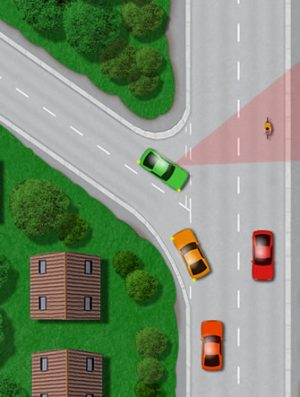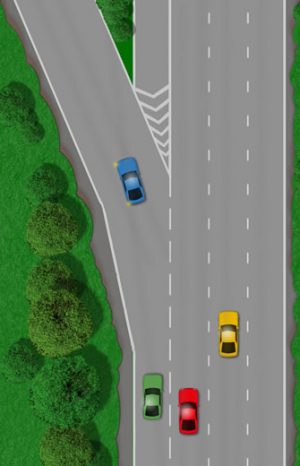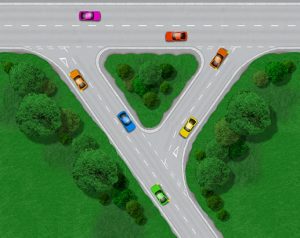Similarly to a T-Junction, a Y-junction gets its name due to being shaped like the letter Y. At a Y-junction, a minor road joins a major road at an acute angle.
Y-junctions come in many forms, some that can be deceptive and unexpected. Y-junctions, as with any other type of junctions can be ‘open’ (easy to see traffic on the opposing road) or ‘closed’ (a blind junction obscured by foliage, fences etc) See road junctions for further information.
They can also be ‘unmarked’ junctions (no road markings – usually found at quiet residential areas or rural locations) or ‘marked’ junctions (with road markings found at busier locations). See types of road junctions.
You should approach all junctions, including Y-junctions using the MSPSL routine. Details for how to correctly do this can be obtained by reading the ‘left and right turns‘ tutorial.
Common Y-Junctions
A typical Y-junction will see the major road going straight ahead which has priority, with a joining minor road exiting / entering to the left or right at an acute angle, forming the letter ‘Y’.

Before entering the major road, the minor road will have ‘give way’ or ‘stop’ signs, along with road markings that inform drivers that they do not have priory.
Junctions can be hazardous. Due to the acute angle of the green car (typical Y-junction image) exiting the minor road onto the major road, A-pillars (the two pillars either side of the windscreen) can often produce a blind spot. This blind spot as can be seen in the image, can easily obscure a cyclist of motorcyclist.
To reduce the risk of accidents, always take sufficient time to look up and down the road at least twice before proceeding. For further information, see:
Dual Carriageways and Motorways
Other common Y-junctions you’re likely to use frequently are located on motorways and dual carriageways. Dedicated lanes can sometimes be used (green car) to enable traffic filtering off the main carriageway at an exit. Road markings differentiate this lane from the others on the carriageway.

This dedicated lane may also be used for vehicles entering the carriageway at a junction prior to this exit. This results in vehicles entering and exiting the same lane.
Motorways and dual carriageways are high speed main routes that have vehicles traveling up to 70mph. In most cases, this exit junction, or ‘slip road’ should be used for slowing the vehicle rather than slowing down on the main carriageway before turning off. Slowing down on the main carriageway can be hazardous for following vehicles.
Main routes such as these can often split into separate directions. This is referred to a ‘fork’ in the road.
Roads that Split at the End
This is a Y-junction with the major road running across the top and the minor road exiting to the south. You can think of it as a Y-junction on a Y-junction.

Sometimes minor roads split off just before they reach the major road. The split is to aid with vehicles exiting the minor road to turn right and for vehicles wishing to turn left into the minor road from the major road.
These access roads (where the yellow car is located) are often very short. Turning off the major road and entering the access road will see the driver met by a junction in very little time. Beware of this at Y-junctions as they can easily surprise a driver that is is not familiar with the road.
TUTORIALS AND GUIDES RELATED TO JUNCTIONS
- Junctions
- Types of junctions
- Turning left at a junction
- Turning right at a junction
- Box junction
- D Junctions
- Staggered junction
- Junction lines
- Junction signs
- Emerging from a junction
- Creep and peep
